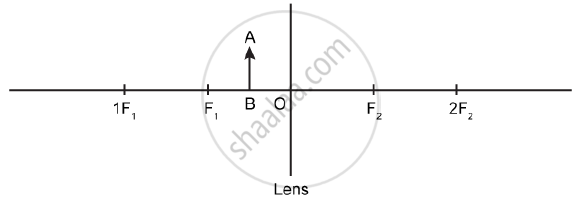Advertisements
Advertisements
प्रश्न
Where should an object be placed in front of a convex lens so as to form an inverted and enlarged image? Will the image be real or virtual? Draw a ray diagram to illustrate your answer.

उत्तर
To form an inverted and enlarged image by a convex lens, the object should be placed between F and 2F in front of the lens.
The image will be real.
The ray diagram is shown in the figure. For the object AB, the images are A’B’.
APPEARS IN
संबंधित प्रश्न
An object AB is placed between O and F1 on the principal axis of a converging lens as shown in the diagram.

Copy the diagram and by using three standard rays starting from point A, obtain an image of the object AB.
Describe with the help of a ray-diagram, the size, nature and position of the image formed by a convex lens when an object is placed beyond 2f in front of the lens.
Name one simple optical instrument in which the above arrangement of convex lens is used.
An object 3 cm high is placed 24 cm away from a convex lens of focal length 8 cm. Find by calculations, the position, height and nature of the image.
A student did an experiment with a convex lens. He put an object at different distances 25 cm, 30 cm, 40 cm, 60 cm and 120 cm from the lens. In each case he measured the distance of the image from the lens. His results were 100 cm, 24 cm, 60 cm, 30 cm and 40 cm, respectively. Unfortunately his results are written in wrong order.
What is the focal length of this lens?
What type of lens is used to correct
hypermetropia
The diagrams (a) and (b) in Figure below show the refraction of a monochromatic ray of light through a parallel sided glass block and a prism respectively. In each diagram, label the incident, refracted emergent rays and the angle of deviation.

Where is the image formed?
What is the difference between a double convex and a bi-convex lens?
Distinguish between Concave lens and Convex Lens.
